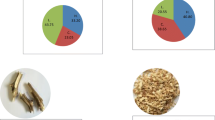Abstract
Activated carbons were prepared from Chinese fir wood by phosphoric acid activation. The effects of heat pretreatment from 80 to 180 °C during impregnation on the properties of fir wood and its activated carbons were discussed. The crystallinity index and surface chemistry of the pretreated fir wood were characterized by X-ray diffraction and Fourier transform infrared spectroscopy (FT-IR). The porous texture of activated carbons was investigated by N2 adsorption–desorption isotherms. The results showed that with increasing pretreatment temperature, the crystallinity of the pretreated samples decreased, which gave rise to a significant development of pores, especially micropores as high as 97.2 %. FT-IR results revealed that the carbonyl-containing and phosphorus-containing groups of the pretreated samples increased with increasing pretreatment temperature. For a temperature of 140 °C, the specific surface area, the total pore volume, and the micropore volume reached a maximum of 1603.0 m2/g, 0.792 cm3/g, and 0.770 cm3/g, respectively. However, a higher pretreatment temperature was not beneficial for activation. Thus, heat pretreatment during impregnation can be regarded as an excellent method for manufacturing phosphoric acid-activated carbon with a high micropore volume.



Similar content being viewed by others
References
Pan S, Pu Y, Foston M, Ragauskas AJ (2012) Compositional characterization and pyrolysis of Loblolly pine and Douglas-fir Bark. Bioenerg Res 6(1):24–34
Sun K, Jiang J (2010) Preparation and characterization of activated carbon from rubber-seed shell by physical activation with steam. Biomass Bioenergy 34(4):539–544
Lim WC, Srinivasakannan C, Balasubramanian N (2010) Activation of palm shells by phosphoric acid impregnation for high yielding activated carbon. J Anal Appl Pyrol 88(2):181–186
Baquero MC, Giraldo L, Moreno JC, Suárez-García F, Martínez-Alonso A, Tascón JMD (2003) Activated carbons by pyrolysis of coffee bean husks in presence of phosphoric acid. J Anal Appl Pyrolysis 70(2):779–784
Zuo S, Yang J, Liu J, Cai X (2009) Significance of the carbonization of volatile pyrolytic products on the properties of activated carbons from phosphoric acid activation of lignocellulosic material. Fuel Proc Technol 90(7–8):994–1001
Molina-Sabio M, Rodríguez-Reinoso F, Caturla F, Sellés MJ (1995) Porosity in granular carbons activated with phosphoric acid. Carbon 33(8):1105–1113
Jagtoyen M, Derbyshire F (1998) Activated carbons from yellow poplar and white oak by H3PO4 activation. Carbon 36(7–8):1085–1097
Puziy AM, Poddubnaya OI, Ziatdinov AM (2006) On the chemical structure of phosphorus compounds in phosphoric acid-activated carbon. Appl Surf Sci 252(23):8036–8038
Bouhamed F, Elouear Z, Bouzid J (2012) Adsorptive removal of copper(II) from aqueous solutions on activated carbon prepared from Tunisian date stones: equilibrium, kinetics and thermodynamics. J Taiwan Inst Chem Eng 43(5):741–749
Zuo S, Liu J, Yang J, Cai X (2009) Effects of the crystallinity of lignocellulosic material on the porosity of phosphoric acid-activated carbon. Carbon 47(15):3578–3580
Marsh H, Rodríguez-Reinoso F (2006) Activated carbon. Elsevier, New York, pp 143–350
Segal L, Creely JJ, Martin AE Jr, Conrad CM (1959) An empirical method for estimating the degree of crystallinity of native cellulose using the X-ray diffractometer. Textile Res J 29(10):786–794
Alvarez AG, Martínez-Escandell M, Molina-Sabio M, RodríguezReinoso F (1999) Pyrolysis of petroleum residues: analysis of semicokes by X-ray diffraction. Carbon 37(10):1627–1632
Fink HP, Philipp B, Paul D (1987) The structure of amorphous cellulose as revealed by wide-angle X-ray scattering. Polymer 28(8):1265–1270
Puziy AM, Poddubnaya OI, Martínez-Alonso A, Suárez-García F, Tascón JMD (2002) Synthetic carbons activated with phosphoric acid: I. Surface chemistry and ion binding properties. Carbon 40(9):1493–1505
Puziy AM, Poddubnaya OI, Martínez-Alonso A, Suárez-García F, Tascón JMD (2003) Synthetic carbons activated with phosphoric acid III. Carbons prepared in air. Carbon 41(6):1181–1191
Fu P, Hu S, Sun L, Xiang J, Yang T, Zhang A (2009) Structural evolution of maize stalk/char particles during pyrolysis. Biores Technol 100(20):4877–4883
Guo Y, Rockstraw DA (2007) Activated carbons prepared from rice hull by one-step phosphoric acid activation. Microporous Mesoporous Mater 100(1–3):12–19
Solum MS, Pugmire RJ, Jagtoyen M, Derbyshire F (1995) Evolution of carbon structure in chemically activated wood. Carbon 33(9):1247–1254
Lozano-Castelló D, Cazorla-Amorós D, Linares-Solano A, Quinn DF (2002) Activated carbon monoliths for methane storage: influence of binder. Carbon 40(15):2817–2825
Taer E, Deraman M, Talib IA, Umar AA, Oyama M, Yunus RM (2010) Physical, electrochemical and supercapacitive properties of activated carbon pellets from pre-carbonized rubber wood sawdust by CO2 activation. Curr Appl Phys 10(4):1071–1075
Sing KSW (1982) The practical importance of porosity. Chem Ind 14:475–477
Moreira RFPM, José HJ, Rodrigues AE (2001) Modification of pore size in activated carbon by polymer deposition and its effects on molecular sieve selectivity. Carbon 39(15):2269–2276
Acknowledgments
We are grateful for the financial support of “Eleventh Five-Year” National Key Technology Program (grant no. 2009BADB1B03) and Research Institutes of Public Service Special Operation Foundation of Fujian Province (grant no. 2011R1013-5).
Author information
Authors and Affiliations
Corresponding author
Rights and permissions
About this article
Cite this article
Lin, G., Jiang, J., Wu, K. et al. Effects of Heat Pretreatment During Impregnation on the Preparation of Activated Carbon from Chinese Fir Wood by Phosphoric Acid Activation. Bioenerg. Res. 6, 1237–1242 (2013). https://doi.org/10.1007/s12155-013-9324-5
Published:
Issue Date:
DOI: https://doi.org/10.1007/s12155-013-9324-5




